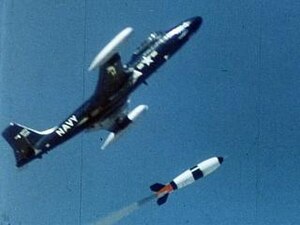
The RUR-5 ASROC is an all-weather, all sea-conditions anti-submarine missile system. Developed by the United States Navy in the 1950s, it was deployed in the 1960s, updated in the 1990s, and eventually installed on over 200 USN surface ships, specifically cruisers, destroyers, and frigates. The ASROC has been deployed on scores of warships of many other navies, including Canada, Germany, Italy, Japan, the Republic of China, Greece, Pakistan and others.

Naval Air Weapons Station (NAWS) China Lake is a large military installation in California that supports the research, testing and evaluation programs of the United States Navy. It is part of Navy Region Southwest under Commander, Navy Installations Command, and was originally known as Naval Ordnance Test Station (NOTS).

The ASM-N-2 Bat was a United States Navy World War II radar-guided glide bomb which was used in combat beginning in April 1944. It was developed and overseen by a unit within the National Bureau of Standards with assistance from the Navy's Bureau of Ordnance, the Massachusetts Institute of Technology, and Bell Telephone Laboratories. It is considered to be the first fully automated guided missile used in combat.

The AUM-N-2 Petrel, also known as Kingfisher C and AUM-2, was an air-to-surface missile produced as part of Project Kingfisher for the United States Navy. Intended for use against enemy surface ships and surfaced submarines, giving aircraft the ability to deliver aerial torpedoes from outside the range of defensive armament, it saw brief operational service in the late 1950s. The project was never considered a high priority by the Navy however, as it was useless against submerged submarines, which were considered the greatest potential threat.

Operation Bumblebee was a US Navy effort to develop surface-to-air missiles (SAMs) to provide a mid-range layer of anti-aircraft defense between anti-aircraft guns in the short range and fighter aircraft operating at long range. A major reason for the Bumblebee efforts was the need to engage bombers before they could launch standoff anti-shipping weapons, as these aircraft might never enter the range of the shipboard guns.

Project Kingfisher was a weapons-development program initiated by the United States Navy during the latter part of World War II. Intended to provide aircraft and surface ships with the ability to deliver torpedoes to targets from outside the range of defensive armament, six different missile concepts were developed; four were selected for full development programs, but only one reached operational service.
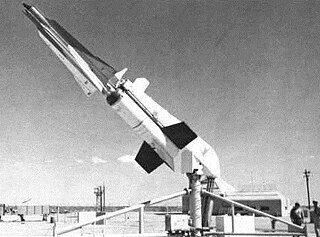
Typhon was a missile system developed by the United States Navy in the late 1950s, intended to serve as an integrated air-defense system for Navy fleets. Consisting of the SAM-N-8 Typhon LR, later designated RIM-50A, and the SAM-N-9 Typhon MR, later RIM-55A, paired with the AN/SPG-59 radar system, the cost of the Typhon system led to it being cancelled in favor of the Standard Missile program.

The Tiny Tim was an American air-to-ground rocket used near the end of the Second World War. It was built in response to a United States Navy requirement for an anti-ship rocket capable of hitting ships from outside of their anti-aircraft range, with a payload capable of sinking heavy shipping. The Tiny Tim was manufactured using 11.75-inch pipe, which was chosen because it was already being manufactured. Used oil field 11.75-inch pipe was acquired for the prototypes. Also, the 11.75-inch size was of interest in the development because there was already available a 500-pound semi-armor-piercing bomb that was adaptable for use as the warhead for the rocket. One of the rocket project scientists commented on the shortage of the piping “.. . we were reduced for a time to the expedient of salvaging [oil-well casing] from abandoned oil wells.”

The NOTS-EV-1 Pilot, better known as NOTSNIK was an expendable launch system and anti-satellite weapon developed by the United States Navy's United States Naval Ordnance Test Station (NOTS). NOTSNIK began as an in-house project using available NOTS funds. The Advanced Research Projects Agency later supplied some funds for the program. The program involved creating transistorized sensors to detect nuclear explosions from the Operation Argus tests. Ten were launched during July and August 1958, all of which failed. It was the first air-launched rocket to be used for an orbital launch attempt; however, none was recorded as having reached orbit. Following the third orbital launch attempt a NOTS engineer at the tracking station in Christchurch, New Zealand reported receiving a weak signal from the spacecraft; This was never confirmed, and the launches were not catalogued as having reached orbit. The Pilot rocket was part of Project Pilot.

The Hopi was an air-to-surface missile developed by the United States Navy's Naval Ordnance Test Station. Intended to provide a medium-range nuclear capability for carrier aircraft, the missile reached the flight test stage during 1958, but the project was cancelled following testing and no production was undertaken.

The RAM, also known as the 6.5-Inch Anti-Tank Aircraft Rocket or ATAR, was an air-to-ground rocket used by the United States Navy during the Korean War. Developed rapidly, the rocket proved successful but was phased out shortly after the end of the conflict.
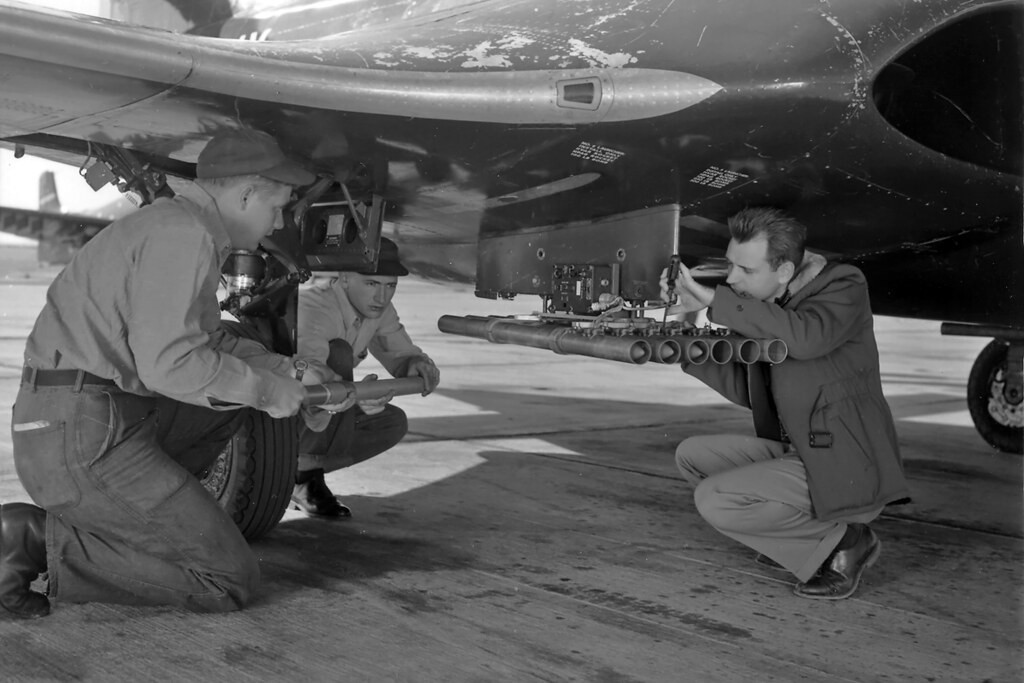
The Gimlet was an unguided air-to-air and air-to-surface rocket developed by the United States Navy during the early 1950s. Although it proved successful in testing and was ordered into large-scale production, the arrival of the guided missile as a practical and reliable weapon resulted in the cancellation of the Gimlet rocket in 1957.
The Diamondback was a proposed nuclear-armed air-to-air missile studied by the United States Navy's Naval Ordnance Test Station during the 1950s. Intended as an enlarged, nuclear-armed version of the successful Sidewinder missile, Diamondback did not progress beyond the study stage.

The Creative Research On Weapons or Crow program was an experimental missile project developed by the United States Navy's Naval Air Missile Test Center during the late 1950s. Intended to evaluate the solid-fueled integral rocket/ramjet (SFIRR) method of propulsion as well as solid-fueled ramjet engines, flight tests were conducted during the early 1960s with mixed success.

The 2.25-Inch Sub-Caliber Aircraft Rocket, or SCAR, was an American unguided rocket developed by the United States Navy during World War II and used for sub-caliber rocket training. Capable of simulating the aerial rockets then coming into operational service, the SCAR was used to train pilots in the use of the new type of weapon, and continued in service throughout the 1950s.
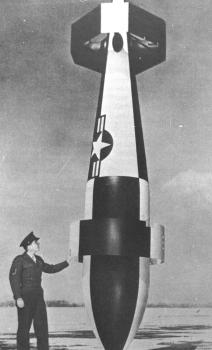
The ASM-A-1 Tarzon, also known as VB-13, was a guided bomb developed by the United States Army Air Forces during the late 1940s. Mating the guidance system of the earlier Razon radio-controlled weapon with a British Tallboy 12,000-pound (5,400 kg) bomb, the ASM-A-1 saw brief operational service in the Korean War before being withdrawn from service in 1951.

The AAM-N-5 Meteor was an early American air-to-air missile, developed by the Massachusetts Institute of Technology and Bell Aircraft for the United States Navy. Initially, both air-launched and ship-launched versions were considered. Versions designed for launch from carrier-based aircraft proceeded to the flight testing stage before the project was cancelled.
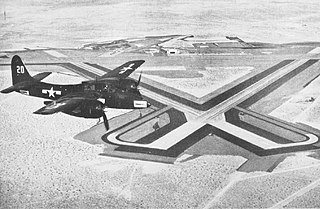
Project Camel encompassed the work performed by the California Institute of Technology (Caltech) in support of the Manhattan Project during World War II. These activities included the development of detonators and other equipment, testing of bomb shapes dropped from Boeing B-29 Superfortress bombers, and the Salt Wells Pilot Plant, where explosive components of nuclear weapons were manufactured.
Television guidance (TGM) is a type of missile guidance system using a television camera in the missile or glide bomb that sends its signal back to the launch platform. There, a weapons officer or bomb aimer watches the image on a television screen and sends corrections to the missile, typically over a radio control link. Television guidance is not a seeker because it is not automated, although semi-automated systems with autopilots to smooth out the motion are known. They should not be confused with contrast seekers, which also use a television camera but are true automated seeker systems.
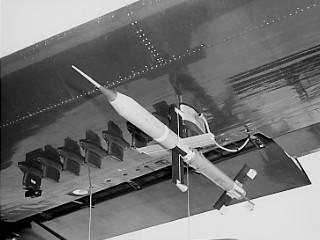
The ASM-N-6 Omar was a short-range air-to-surface missile developed for and evaluated by the United States Navy in the early 1950s. Intended to use existing unguided rockets as a basis and using a novel guidance system involving optical beam-riding, the program was unable to resolve difficulties with the guidance system and was cancelled without entering service.
